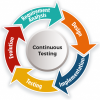Related Content
 |
Continuous Testing Is Not Automation Many people confuse continuous testing with test automation. That makes sense, because you cannot do continuous testing without automated tests. But it is much more. Continuous testing has a higher-level maturity that could require a totally different way of working—but it also gives a faster path to production. |
|
 |
How Are You Managing Your Test Debt? Just as debt can be good and bad in everyday life (such as a home mortgage), debt in the engineering world can also be good and bad. This applies to quality engineering as well—with good and bad test debt. As testers, how do we create a balance and stay at the right test-debt quotient? |
|
 |
Stop Hoarding Bugs and Clean Up Your Backlog Many testing organizations have bugs sitting in their bug-tracking tool gathering dust. The issues aren't high-priority enough to fix immediately, but no one wants to close them because they might get around to fixing them eventually. This is a hoarder mentality! You need to organize and declutter your bug backlog. |
|
 |
Testing Centers of Excellence and the Return of Silos Testing centers of excellence aim to be R&D labs for software testing, experimenting, and innovating new testing techniques and then piloting them on projects and analyzing the results. But that's not always the reality. Some CoEs merely isolate testers, taking a step back to the days of silos. What's your experience? |
|
 |
The Testing Practices and Metrics That Really Matter in Agile and DevOps Scaled agile and DevOps change the game for software testing. It’s not just a matter of accelerating testing; it’s also about fundamentally altering the way we measure quality. The test outcomes required to drive a fully automated release pipeline are dramatically different from the ones most teams measure today. |
|
 |
A Tester’s Role in Requirements Exploration Agile is supposed to get people to talk to each other in real time. However, many teams still lack a shared understanding of what they are going to build, even as they start coding. As testers, we can explore feature specifications early, contributing to successful and timely delivery through defined requirements. |
|
 |
Testing at 43,000 Feet: Reporting Risk That Matters Many teams' daily testing gets broken down into numbers. If you're used to dashboards, it can be easy to forget the prime objective: to raise up quality issues—or, in the case of safety-critical devices, potential hazards. Graphs are comfortable, but do they really provide the information we should be looking for? |
|
 |
Improving Requirements with Preemptive Testing Most product defects are created during requirements definition. To significantly reduce and prevent requirements problems, consider making their management your software testers' responsibility. They can identify requirements defects as they are being developed, as well as work out mitigations for their root causes. |








